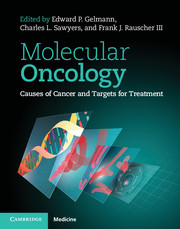Book contents
- Frontmatter
- Dedication
- Contents
- List of Contributors
- Preface
- Part 1.1 Analytical techniques: analysis of DNA
- Part 1.2 Analytical techniques: analysis of RNA
- Part 2.1 Molecular pathways underlying carcinogenesis: signal transduction
- 10 HER
- 11 The insulin–insulin-like growth-factor receptor family as a therapeutic target in oncology
- 12 TGF-β signaling in stem cells and tumorigenesis
- 13 Platelet-derived growth factor
- 14 FMS-related tyrosine kinase 3
- 15 ALK: Anaplastic lymphoma kinase
- 16 The FGF signaling axis in prostate tumorigenesis
- 17 Hepatocyte growth factor/Met signaling in cancer
- 18 PI3K
- 19 Intra-cellular tyrosine kinase
- 20 WNT signaling in neoplasia
- 21 Ras
- 22 BRAF mutations in human cancer: biologic and therapeutic implications
- 23 Aurora kinases in cancer: an opportunity for targeted therapy
- 24 14-3-3 proteins in cancer
- 25 STAT signaling as a molecular target for cancer therapy
- 26 The MYC oncogene family in human cancer
- 27 Jun proteins and AP-1 in tumorigenesis
- 28 Forkhead box proteins: the tuning forks in cancer development and treatment
- 29 NF-κB and cancer
- Part 2.2 Molecular pathways underlying carcinogenesis: apoptosis
- Part 2.3 Molecular pathways underlying carcinogenesis: nuclear receptors
- Part 2.4 Molecular pathways underlying carcinogenesis: DNA repair
- Part 2.5 Molecular pathways underlying carcinogenesis: cell cycle
- Part 2.6 Molecular pathways underlying carcinogenesis: other pathways
- Part 3.1 Molecular pathology: carcinomas
- Part 3.2 Molecular pathology: cancers of the nervous system
- Part 3.3 Molecular pathology: cancers of the skin
- Part 3.4 Molecular pathology: endocrine cancers
- Part 3.5 Molecular pathology: adult sarcomas
- Part 3.6 Molecular pathology: lymphoma and leukemia
- Part 3.7 Molecular pathology: pediatric solid tumors
- Part 4 Pharmacologic targeting of oncogenic pathways
- Index
- References
27 - Jun proteins and AP-1 in tumorigenesis
from Part 2.1 - Molecular pathways underlying carcinogenesis: signal transduction
Published online by Cambridge University Press: 05 February 2015
- Frontmatter
- Dedication
- Contents
- List of Contributors
- Preface
- Part 1.1 Analytical techniques: analysis of DNA
- Part 1.2 Analytical techniques: analysis of RNA
- Part 2.1 Molecular pathways underlying carcinogenesis: signal transduction
- 10 HER
- 11 The insulin–insulin-like growth-factor receptor family as a therapeutic target in oncology
- 12 TGF-β signaling in stem cells and tumorigenesis
- 13 Platelet-derived growth factor
- 14 FMS-related tyrosine kinase 3
- 15 ALK: Anaplastic lymphoma kinase
- 16 The FGF signaling axis in prostate tumorigenesis
- 17 Hepatocyte growth factor/Met signaling in cancer
- 18 PI3K
- 19 Intra-cellular tyrosine kinase
- 20 WNT signaling in neoplasia
- 21 Ras
- 22 BRAF mutations in human cancer: biologic and therapeutic implications
- 23 Aurora kinases in cancer: an opportunity for targeted therapy
- 24 14-3-3 proteins in cancer
- 25 STAT signaling as a molecular target for cancer therapy
- 26 The MYC oncogene family in human cancer
- 27 Jun proteins and AP-1 in tumorigenesis
- 28 Forkhead box proteins: the tuning forks in cancer development and treatment
- 29 NF-κB and cancer
- Part 2.2 Molecular pathways underlying carcinogenesis: apoptosis
- Part 2.3 Molecular pathways underlying carcinogenesis: nuclear receptors
- Part 2.4 Molecular pathways underlying carcinogenesis: DNA repair
- Part 2.5 Molecular pathways underlying carcinogenesis: cell cycle
- Part 2.6 Molecular pathways underlying carcinogenesis: other pathways
- Part 3.1 Molecular pathology: carcinomas
- Part 3.2 Molecular pathology: cancers of the nervous system
- Part 3.3 Molecular pathology: cancers of the skin
- Part 3.4 Molecular pathology: endocrine cancers
- Part 3.5 Molecular pathology: adult sarcomas
- Part 3.6 Molecular pathology: lymphoma and leukemia
- Part 3.7 Molecular pathology: pediatric solid tumors
- Part 4 Pharmacologic targeting of oncogenic pathways
- Index
- References
Summary
AP-1
Activating protein 1 (AP-1) is a dimeric transcription factor which serves as an integrator of numerous signals to regulate gene expression affecting cellular proliferation, differentiation, apoptosis, autophagy, inflammation, cellular migration, and neoplastic transformation. AP-1 is composed of proteins from several families whose common denominator is the possession of basic leucine-zipper (bZIP) domains that are essential for dimerization and DNA binding. Jun (c-Jun, JunB, and JunD) and Fos (c-Fos, FosB, Fra1, and Fra2) subfamilies are the major AP-1 proteins. ATF proteins ATF2, LRF1/ATF3, B-ATF, JDP1, and JDP2 are also components of AP-1, and the Maf subfamily, which includes c-Maf, MafB, MafA, MafG/F/K, and Nrl are considered to be close relatives which form heterodimers with Fos and Jun, and occupy AP-1 binding sites. Jun–Fos heterodimers bind preferentially to a heptamer consensus sequence known as the TPA responsive element (TRE; 5ʹ-TGA(C/G)TCA-3ʹ), whereas Jun-ATF dimers bind with higher affinity to another consensus sequence known as the cyclic AMP responsive element (CRE; 5ʹ- TGACGTCA -3ʹ). The seven Fos-Jun family members can form 18 different homo- and heterodimers. The composition of the dimers varies among different tissues, regulated by exposure to different stimuli, and determines specificity of the binding site and consequently the identity of activated genes (1). Increased diversity of AP-1 and consequently increased complexity, is also generated by the ability of “core AP-1 proteins” Jun and Fos to interact with other leucine-zipper-containing proteins, sometimes resulting in binding to novel DNA elements (2). Additional layers of complexity may stem from interactions of AP-1 components with structurally unrelated proteins which recruit them to other divergent binding sites on the DNA in order to regulate gene transcription (1).
- Type
- Chapter
- Information
- Molecular OncologyCauses of Cancer and Targets for Treatment, pp. 319 - 327Publisher: Cambridge University PressPrint publication year: 2013

